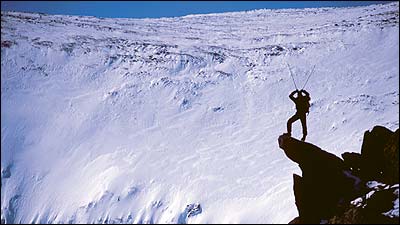The Adrenaline Junkie

For I.T. project manager Ethan Bregman, life’s pleasures fall into two camps: extreme sports and extreme snow sports. In the former category are hobbies like bungee jumping, surfing, and spelunking; in the latter, skiing, snowboarding, and the like. Bregman has traveled from Jackson Hole to Chamonix in search of snowy thrills; on a recent trip to New Zealand, he went heli-skiing, then hiked a 9,000-foot active volcano. “It was heaven.” Now he’s looking for a new thrill—but not just any new thrill. “I’m not a snob snob,” he says, “but I am a snow snob.”
Mount Washington

“Ice,” I yelled, as a chunk the size of a dinner plate peeled away from the frozen waterfall. I watched as it pinballed between the lichen-covered granite walls of the gully, barely missing my partner, Robert, 100 feet below. “Sorry, bro,” I called down, rearing back for another swing. This time, my ax hit with a resounding thwack, causing the tool to vibrate in my hand like a tuning fork. I looked up just in time to see a shower of spindrift falling toward me. A second later, powder filled my collar and a hoary coating of frost covered my face. My suffer meter was fully pegged in the red zone—so why did I find myself grinning?
Mount Washington, the 6,288-foot crown jewel of New Hampshire’s White Mountains, is the northeast’s premier destination for ice climbing. Every winter, thousands of climbers, many of them newcomers to the sport, travel here from all over the country to test themselves on these slopes. But this is not a place for the faint of heart. In the middle of winter, the temperature can drop to minus 30; a world-record 231-mile-an-hour wind was recorded on the summit in April 1934, and more than 100 people have lost their lives here. Yet this is exactly why guys like Rob and me find ourselves coming back time and again. Somewhere deep inside every ice climber is a barbarian who craves hard work and sticky situations where survival can’t be taken for granted.
If you’re new to ice climbing, hire a guide. You’ll start out working on the basic rope-ice-ax-and-crampon technique on a small ice floe in town before graduating to an ascent of the mountain. Routes vary from a walk to the summit via the Lion Head trail to a roped ascent of steep ice and rock in Huntington Ravine. The hike from Pinkham Notch into Huntington follows the Tuckerman Ravine Trail through a dense coniferous forest crawling with bears, wildcats, and moose. Just past the 1.3-mile mark lies the Harvard Cabin, a cozy two-story hut with a wood stove, drying racks for your wet gear, plus whatever cookware you’ll need to get you through the night.
I’ve lived beneath Mount Washington off and on for twenty years, yet the thrill of stepping into Huntington Ravine has never worn off. The ravine boasts almost 900 feet of vertical relief and is essentially a giant, above-treeline amphitheater, its flanks lined with ice gullies. For our ascent, Rob and I chose the most classic of all: Pinnacle Gully, a 600-foot shaft of ice that’s less than 6 feet across at its narrowest. Two hours later, I was scraping the frost off my face and contemplating the deteriorating weather. At that point, I realized it would be significantly easier to finish the climb and hike down the Lion Head trail than to try and rappel back down the way we came up. The commitment of our position gave me a fluttery, anxious feeling—which just happened to be exactly what I went up there to find. If you like to take the easy path in life, a winter ascent on Mount Washington probably isn’t for you. But if you’re like us, and you like doing things the hard way, Mount Washington will be waiting.
The International Mountain Climbing School in North Conway offers private ice-climbing courses from $200 a day (603-356-7064). Accommodations at the Harvard Cabin ($15 a person) are first-come, first-served; bring cash for the caretaker.